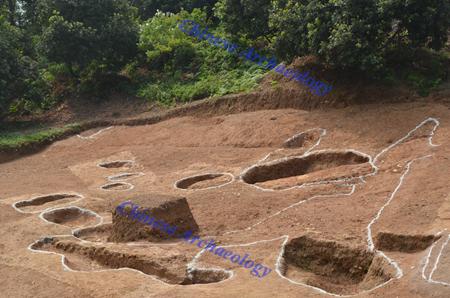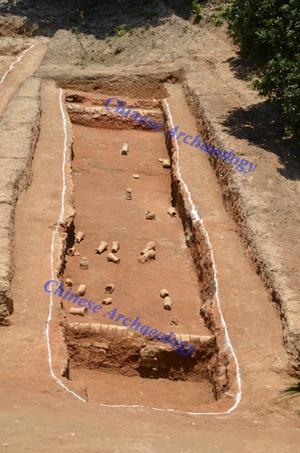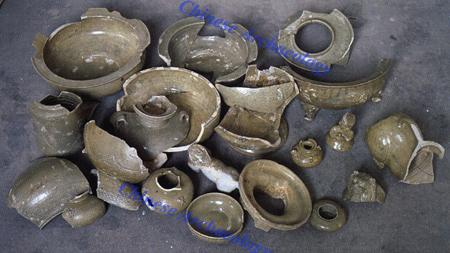Chinese Institute of Archaeology
Source - http://www.kaogu.cn/en/News/New_discoveries/2015/0415/49907.html
More than forty sites with Yueyao kiln ruins were newly discovered at the southern base of Jinshan Mountain in Shaoxing prefecture, Zhejiang province. Current surveys confirm the existence of at least 180 kiln sites within the general region, including 80 from the Eastern Han Dynasty (25-220 AD) and 60 from the Three Kingdoms period (220-280 AD) and Western Jin Dynasty (265-316 AD).The newly-discovered sites were primarily from the Eastern Han era and provide a wealth of information about the origin and development of celadon ceramics.

Deposit layers from East Han dynasty to West Jin dynasy
The entire group of kiln sites is concentrated along both shores of the Cao’ejiang River Basin, showing the important role that water transport played in the development and growth of the ceramics industry.
The discoveries of the current survey included 12 new Jinshan kilns sites, which together form one large group of kilns situated along the northern and western edges of Jinshan Lake.
Zhejiang Provincial Institute of Cultural Relics and Archaeology and other work units conducted archaeological excavations at the Jinshan kiln site from May to October 2014. Excavation of an 800 sq meter area exposed abundant ruins and artifacts, including kiln furnaces, ash pits, ash ditch, and a large quantity of high-quality, high-grade finished celadon ceramics. These current excavations, with large number of kiln furnaces and rich kiln remains, reveal early development of celadon kilns.

Workshop ruins
The kiln site is located within a narrow valley facing approximately north-south, on the northern side of the Jinshan lake. The site entrance is open and flat and has the greatest abundance of historical remains, judging from the artisan workshop area placement, while a zone dedicated to kiln firing is located on both sides of a hilltop. Three dragon kilns were found altogether, including one of the earliest Eastern Han Dynasty kiln furnaces, located on the eastern side of the hill. Two kiln furnaces from the Three Kingdoms period and Western Jin Dynasty era are situated in a basic side-by-side configuration on the opposing western hillside. Within the deepest part of the valley is a dump site for the kiln group’s production rejects and waste products. The layout appears logical and orderly.

Long sloped dragon kiln furnace
Three long, sloped, semi-subterranean, strip-shaped dragon kilns, each made up of three distinct sections (fire chamber, kiln bed, and smoke extraction chamber), were discovered relatively intact. Among these, Y1 is approximately 13.6 meters long and 2.2 meters wide, with a large fire chamber in the slightly rectangular front section and a smoke extraction room with a row of six exhaust holes in its back bottom, in the rectangular rear section. The kiln furnace has both large-scale firing equipment and nail-shaped tripod feet bases. The size, composition, and equipment of Y2 are similar to Y1, with the biggest variation in the slope of the kiln bed. The slope of Y2 starts gently in the front and becomes very steep in the back. Kiln Y3 is significantly longer, approximately 16 meters, with abundant and diverse equipment. The height and quality of its firing equipment is different and it does not appear to have nail-shaped tripod feet bases. A new “zigzag” or “sawtooth” form emerges in this kiln. Taking into consideration structure, loading/firing process, and the unearthed kiln products, these three kiln furnaces seem to represent a relatively complete sequence of kiln development from the Eastern Han Dynasty through the Three Kingdoms period and Western Jin Dynasty

Unearthed porcelain samples
A great amount of ash pits were concentrated at the widest, most level part of the kiln entrance. The ash pits have a regular shape and are comparatively large and deep, with a thin layer of pure clay at the bottom. They were possibly used as a storage pit for clay bases. Well-preserved traces of casting and so forth from early period pottery kilns are difficult to find, making this kiln workshop discovery very significant.
All samples of unearthed products were mature celadon, and there were many forms, including zun (goblet), gui (food vessel with round mouth and handles), xi (round wash basin), pen (bowl or plate), deng (lantern), guan (jar), and so forth. Altogether there were nearly 30 different types of items, all with high-quality glaze and gorgeous decorations. The manufacturing and firing technology appear to be mature (fully developed) and sophisticated, representing the first peak in the progress of celadon ceramics.
Excavation significance
Discovery of a new category of Han Dynasty ceramics has great importance for the exploration of the origin and early development of celadon.
The three dragon kilns at Jinshan were preserved relatively intact. All have differences in certain aspects, such as length and slope, casting and firing equipment, finished products, and so forth, which are representative of the development process of loading/firing equipment from the Eastern Han Dynasty to the Three Kingdoms and Western Jin periods. Yueyao kiln furnace ruins at identical kiln sites discovered at different times are still classified as the first discovery of early period Yueyao kilns in the historical development of celadon.
Jinshan kiln furnace Y2 is deeper and a more complete structure than other early period dragon kiln furnaces currently known to science. The fire chamber, kiln bed, and smoke extraction chamber are all relatively intact. The above-mentioned kiln furnace has the majority of its main section underground. Whether or not a kiln possesses this style has an important significance with regards to recognizing the stages in early period dragon celadon kiln development.
Kiln section compartmentalization equipments are the significant invention of the Jinshan kilns; furthermore, other improvements can be seen, from the nail-shaped tripod feet bases gradually transitioning to the sawtooth (zigzag) shape. Such continuous improvements not only enormously improved firing capacity, but also enormously improved the artistry and beauty of the vessels produced.
(Translator: Grace Warren)